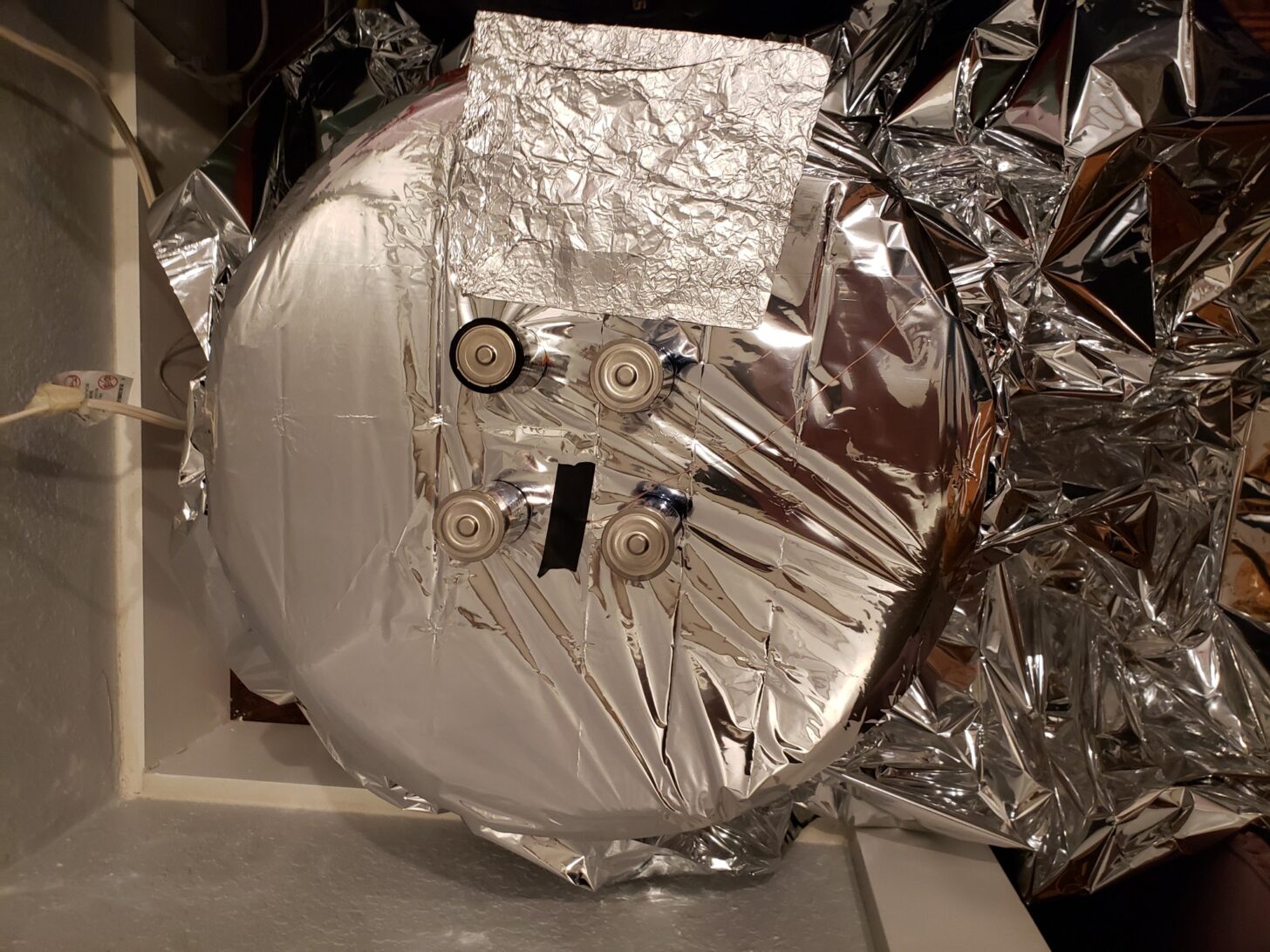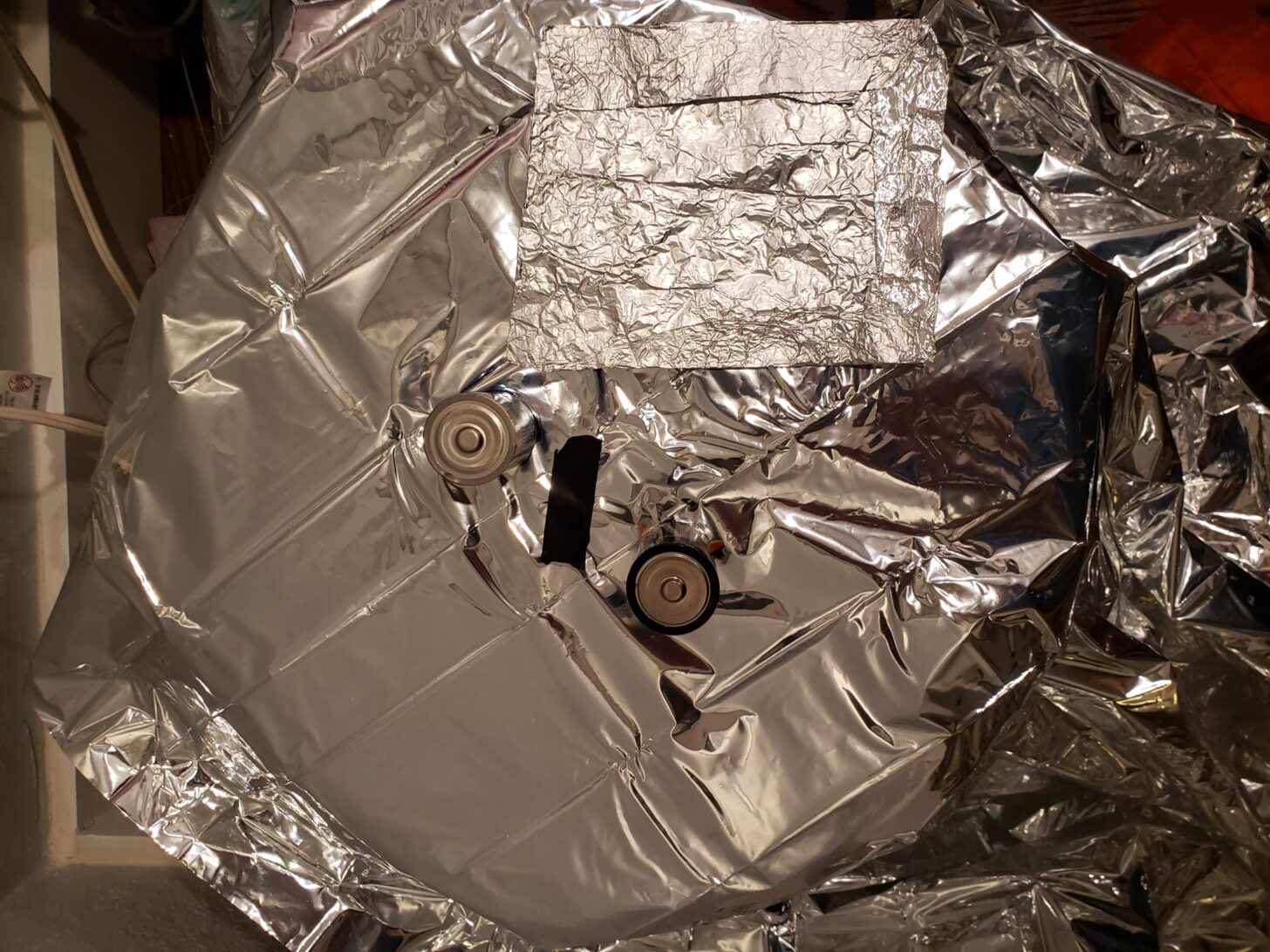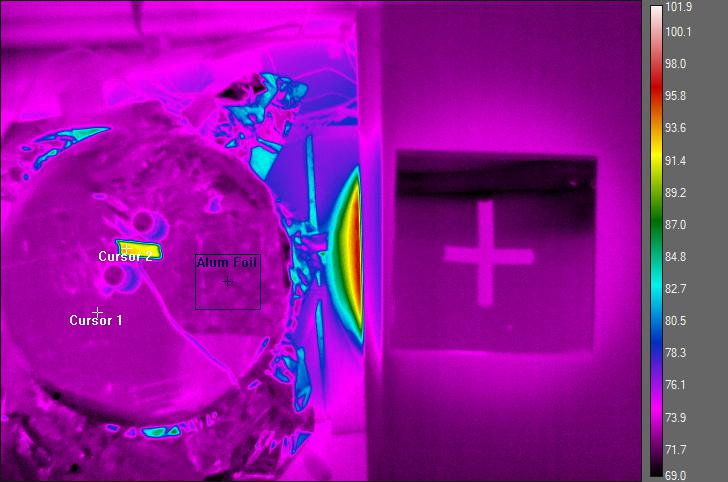In By the Numbers, Stephen Seeber turns a critical eye towards fabrics and materials by testing for claims, degradation, and more.
Introduction
Not all space blankets are created equal. Even if they look identical to the eye, their infrared wavelength performance may be inadequate. I am in the process of building an instrument that requires radiant heat barriers that are reasonably robust. So, I thought I could cut up space blanket fabric and install it on the device. This provided me with an opportunity to test some space blankets and determine which one had the best infrared reflective properties.
I went to Dick’s Sporting Goods. They had two different space blankets available. They both sold for around $15. The first is made by Field and Stream and is called Survival Reflect Blanket. The package claims it conserves up to 90% of body heat. The second is made by Survival Outdoors Longer (SOL) and is called the SOL Survival Blanket. The same material is used in the slightly larger, and more usable, SOL Emergency Blanket. The package claims it reflects 90% of heat. I purchased both for my test.

How a Space Blanket Works
There are several ways that heat is transferred from your body to the environment. When you are sitting on a cold rock, heat is transferred via conduction through your clothes that are in contact with the rock. The heat from your body can also be transferred by convection which means that heat from your body warms adjacent air, which then carries the heat away. When you are sweating, the sweat can evaporate. Evaporation is the process of changing from liquid to gas, and it requires heat energy which can be extracted from the skin.
Finally, any surfaces (skin or clothing) can transfer energy through radiant exchange with the ambient (as long as the ambient temperature is lower than your body or clothing surfaces). Radiant heat exchange moves heat from a hot surface to a cool surface by means of electromagnetic energy in the infrared (IR) spectrum. This spectrum extends from 0.7 to 1,000 microns wavelength. Heat transfer from the body occurs primarily in the near and middle portions of the infrared spectrum—0.7 to 25 microns.
Infrared energy, like visible light energy, can be reflected. The ability of an object to reflect infrared energy is described by a physical characteristic called emissivity, and it can be measured. A material with an emissivity of 0 is a perfect reflector—it emits no infrared energy as a result of its own temperature, but will reflect any infrared energy that strikes its surface. A material with an emissivity of 1 provides no heat reflection but is a perfect emitter of infrared energy resulting from its own temperature. All real materials have an emissivity of greater than 0 but less than 1. Aluminum foil can have an emissivity of 0.05. This means that it emits almost no infrared energy as a result of its surface temperature, but it reflects nearly all incident infrared energy. Electrical tape can have an emissivity of 0.96. It will reflect almost no incident infrared energy.

If a material that is reflective of infrared is placed between the source of heat (your skin, for example) and the ambient, transmission of heat to the ambient can be minimized and your rate of cooling will be reduced. If the infrared material is placed directly on the skin with the reflective surface facing the skin, reflection does not occur. Instead, conductive heat transfer from the skin will heat the material. If the outward surface of the material has a high emissivity, the heat conducted into the material from the skin will be emitted to the ambient and you will continue to lose heat. Space blankets are often reflective on both sides. This means, where the blanket is warmed through direct contact with a body or clothing surface, the reflective outer surface of the fabric will limit or prevent radiant transfer that results from conductive heat transfer into the space blanket.
The most effective radiant blanket will be highly reflective of infrared on both sides. A less effective heat blanket will be highly reflective on just one side and that side should usually face the cold ambient. An ineffective space blanket will have moderate to high emissivity and will not prevent the maximum transfer of radiant energy.
Well, how can you tell which is better when you buy one? You cannot. Space blankets can have an identical appearance in visible light but can still perform very differently in the infrared wavelengths. The only way to know is to measure the emissivity, which requires, at minimum, a thermal imager.
Analysis
To test them, I mounted the space blankets on a permeation kettle with water heated to 120 F (48.9 C), while the room ambient is around 72 F (22.2 C). Visual inspection shows that both materials have the same appearance. With a thermal imager, a qualitative comparison is simple: A highly reflective object will show the ambient temperature when observed through the thermal imager. To that end, a piece of crinkled aluminum foil is placed on each space blanket. If the infrared image appears warmer than the aluminum foil, then the emissivity is too high for effective blanket performance. We see from the images that the Field and Stream blanket material is not a great reflector.

However, we see that the apparent blanket temperature of the SOL material matches the apparent temperature of the aluminum foil. Thus, the SOL blanket will be the better reflector and can be expected to provide good performance.

When we measure the emissivity in 8-12 microns, we find the emissivity of the Field and Stream blanket is 0.64, and the SOL emissivity is 0.13. Therefore, the SOL blanket is a much better reflector.

How to Use the SOL Survival/Emergency Blanket
Both sides of the Field and Stream blanket have a similar finish. The SOL blanket has an orange foil appearance on one side and silver on the other. This is seen in the following image:

The measured emissivity of the orange side is similar to that of the Field and Stream Blanket. So, the orange side is a poor reflector, compared with the silver side.
I suggest, when using the SOL blanket, the silver (shiny) side should face the ambient (outside) environment. This will provide the lowest possible radiant heat transfer. The product photograph on the package shows two people huddled together wrapped in the blanket with the orange side out. One clear advantage of the orange side out is that visibility is improved if someone is searching for you. A minor benefit of using the blanket with the orange side out is the absorption of some solar gain. However, since the orange side is still somewhat reflective, it may take some very strong sunshine to feel its heating effect.
Never use a space blanket under another layer (unless you want it to function as a vapor barrier). A layer placed over the space blanket would eliminate most of the reduction in radiant heat transfer.
Related Content
- More by Stephen Seeber.
- Read Rex Sanders’ interview with Stephen for the Standards Watch column.
- In the forums: Should I Bother With a Space Blanket?



Home › Forums › By the Numbers: If You Carry a Space Blanket, Buyer Beware